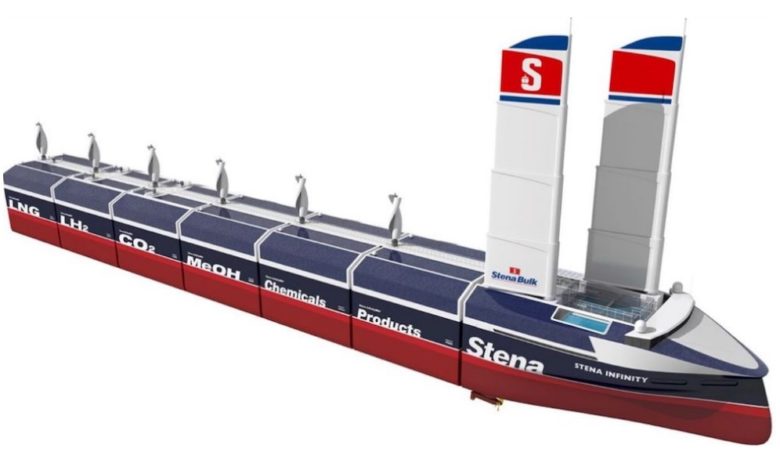Stena Bulk unveils hybrid zero-emissions concept design

A Swedish shipowner with a history of launching groundbreaking new ships has given the world a futuristic, eye-catching, hybrid bulk carrier design.
Stena Bulk, one of Scandinavia’s largest tanker players, unveiled its InfinityMAX concept vessel design yesterday. The zero emissions ship can carry both dry and wet cargoes in modular compartments, something Stena Bulk claimed could have as big an impact on shipping as the advert of containerisation in the 1950s.
“The creation of standardised and modular cargo units that can carry dry bulk, liquid bulk or liquified gas products – such as methane, hydrogen or ammonia – will significantly streamline the process of transporting wet and dry bulk cargoes,” Stena Bulk stated in a release.
The InfinityMAX design, Stena Bulk maintains, drives improved world fleet utilisation and the potential for more standardised supply chains, as well as reducing the unnecessary environmental impact of empty tanks being shipped around the world in search of new cargo.
This is innovative, provocative and would radically reshape the way we think about bulk trade, rationalising two segments into one
Each of the InfinityMAX’s modular cargo units are designed to be totally self-sufficient in terms of their energy use, with wind turbines and solar panels generating all the electricity needed for internal systems. The modular units have also been designed to be able to be dropped off outside of ports and picked up by tugs, avoiding congestion and reducing call times dramatically. The InfinityMAX concept will use hydrogen as a marine fuel and wind turbines to generate further energy. Collapsible wing sails and a shark skin hull have also been incorporated in the concept design to significantly improve efficiency.
Although the vessels will be crewed for safety and flexibility reasons, Stena Bulk has designed the InfinityMAX concept to be semi-autonomous.
Erik Hånell, president and CEO of Stena Bulk, commented: “We are extremely proud to unveil our InfinityMAX concept vessel design, which we believe pushes the boundaries for the future of our industry. What we are proposing here is innovative, provocative and would radically reshape the way we think about bulk trade, rationalising two segments with complimentary expertise into one shipping segment that is ready for the challenges of the future.”
Hånell said that a core philosophy at Stena Bulk states innovation is key to commercial success.
“By 2050, the growing need for transportation of energy from areas with abundant renewable supply to areas with large energy demand – carried as hydrogen, methanol, methane, and ammonia – will be a defining part of international trade,” Stena Bulk predicted in a release yesterday. “This, combined with the requirement to transport sustainable, edible oils and chemicals, and carbon dioxide from carbon capture facilities, as well as bulk commodities, requires a vessel design that is up to the challenge of a radically reformed global economy.”
Stena Bulk believes that an InfinityMAX vessel could come into service between 2030 and 2035.
“To achieve this,” the company stated yesterday, “a strengthened and sustained collaborative spirit between industry and technology leaders is a necessity in the coming years.”
Stena Bulk has a long history of bringing new-look ships to the industry, latterly led via its various MAX designs. Across the various divisions at Stena many other transformations are underway including plans to become the world’s first decarbonisation exploration driller as well as the Stena Elektra, a futuristic looking hybrid ferry.
